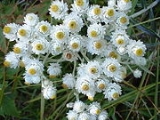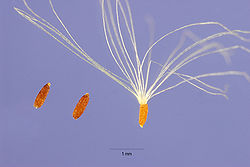
Pearly everlasting
Encyclopedia

Asteraceae
The Asteraceae or Compositae , is an exceedingly large and widespread family of vascular plants. The group has more than 22,750 currently accepted species, spread across 1620 genera and 12 subfamilies...
whose members are commonly known by the name Pearly everlasting. There are around 110 species within the genus with the vast majority being native to central and southern Asia
Asia
Asia is the world's largest and most populous continent, located primarily in the eastern and northern hemispheres. It covers 8.7% of the Earth's total surface area and with approximately 3.879 billion people, it hosts 60% of the world's current human population...
. There is one species native to North America
North America
North America is a continent wholly within the Northern Hemisphere and almost wholly within the Western Hemisphere. It is also considered a northern subcontinent of the Americas...
that is fairly well known and popular in cultivation, namely the Western Pearly Everlasting (Anaphalis margaritacea
Anaphalis margaritacea
Anapahlis margaritacea, commonly known as the Western Pearly Everlasting, is a perennial herb in the composite family. Since it is the only North American species it is often simply called Pearly Everlasting in the United States and Canada. However, it is also native in Asia and has been widely...
).
The name probably derives from the common practice of drying the flowers and stems for decorations through winter months. The Pearly everlasting was used extensively by Native Americans
Indigenous peoples of the Americas
The indigenous peoples of the Americas are the pre-Columbian inhabitants of North and South America, their descendants and other ethnic groups who are identified with those peoples. Indigenous peoples are known in Canada as Aboriginal peoples, and in the United States as Native Americans...
for a variety of medicinal purposes.
Two of the species, A. javanica
Anaphalis javanica
Anaphalis javanica or Javanese Edelweiss is a flowering plant species endemic to Indonesia. They are found mostly in mountainous regions of Java, southern Sumatra, southern Sulawesi and Lombok. Although a mature plant can reach eight metres in height, most specimens are less than a metre tall. The...
and A. longifolia can be found on the mountain af the Java
Java
Java is an island of Indonesia. With a population of 135 million , it is the world's most populous island, and one of the most densely populated regions in the world. It is home to 60% of Indonesia's population. The Indonesian capital city, Jakarta, is in west Java...
island in Indonesia
Indonesia
Indonesia , officially the Republic of Indonesia , is a country in Southeast Asia and Oceania. Indonesia is an archipelago comprising approximately 13,000 islands. It has 33 provinces with over 238 million people, and is the world's fourth most populous country. Indonesia is a republic, with an...
. A. javanica, also known as the Javanese Edelweiss, is currently an endangered species.
Selected species
- Anaphalis javanicaAnaphalis javanicaAnaphalis javanica or Javanese Edelweiss is a flowering plant species endemic to Indonesia. They are found mostly in mountainous regions of Java, southern Sumatra, southern Sulawesi and Lombok. Although a mature plant can reach eight metres in height, most specimens are less than a metre tall. The...
(Javanese Edelweiss) - Anaphalis longiflora
- Anaphalis longifolia
- Anaphalis lorentzii
- Anaphalis margaritaceaAnaphalis margaritaceaAnapahlis margaritacea, commonly known as the Western Pearly Everlasting, is a perennial herb in the composite family. Since it is the only North American species it is often simply called Pearly Everlasting in the United States and Canada. However, it is also native in Asia and has been widely...
- Western Pearly Everlasting - Anaphalis viscida - found in Mount Tambora, Indonesia

